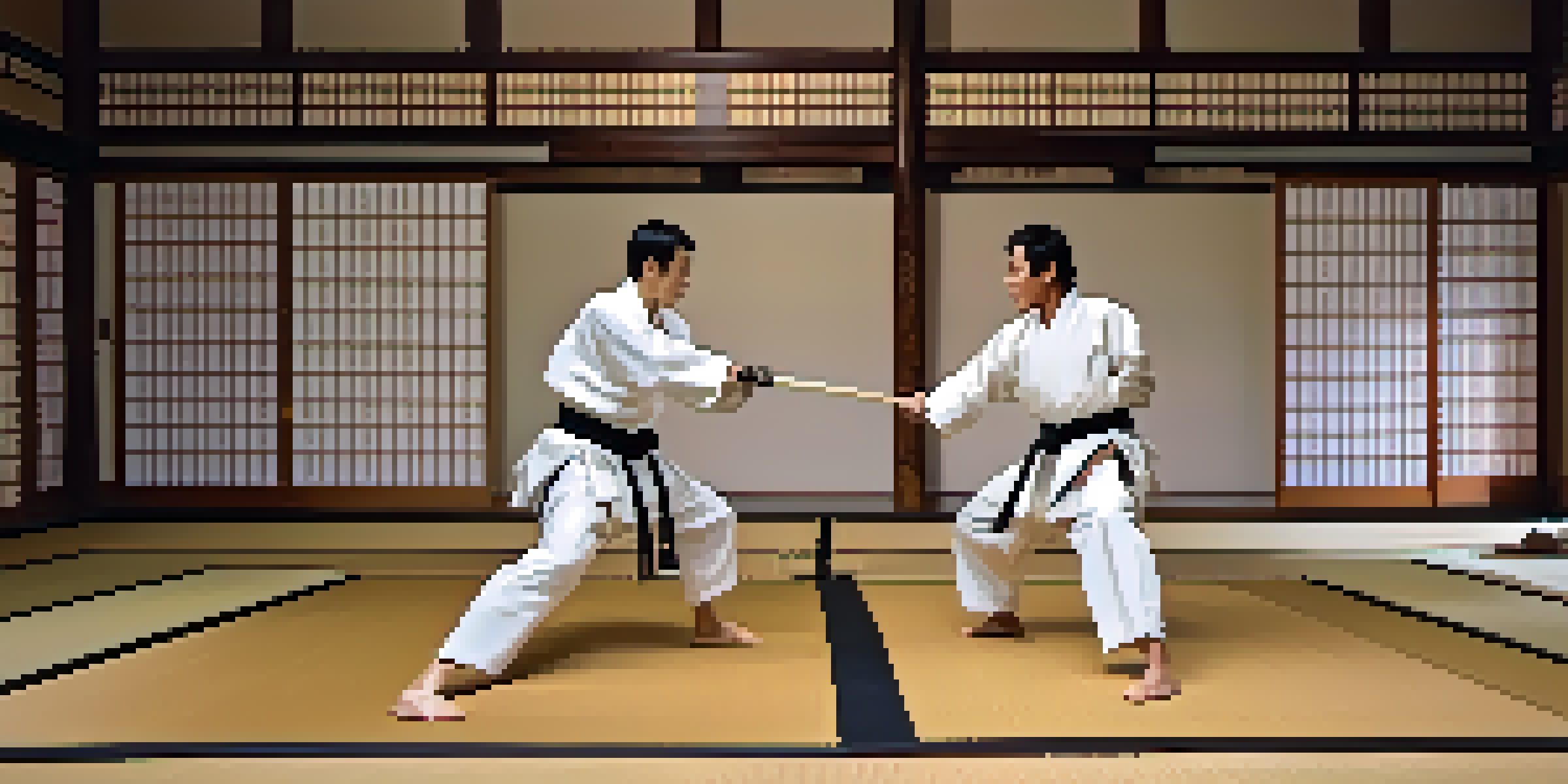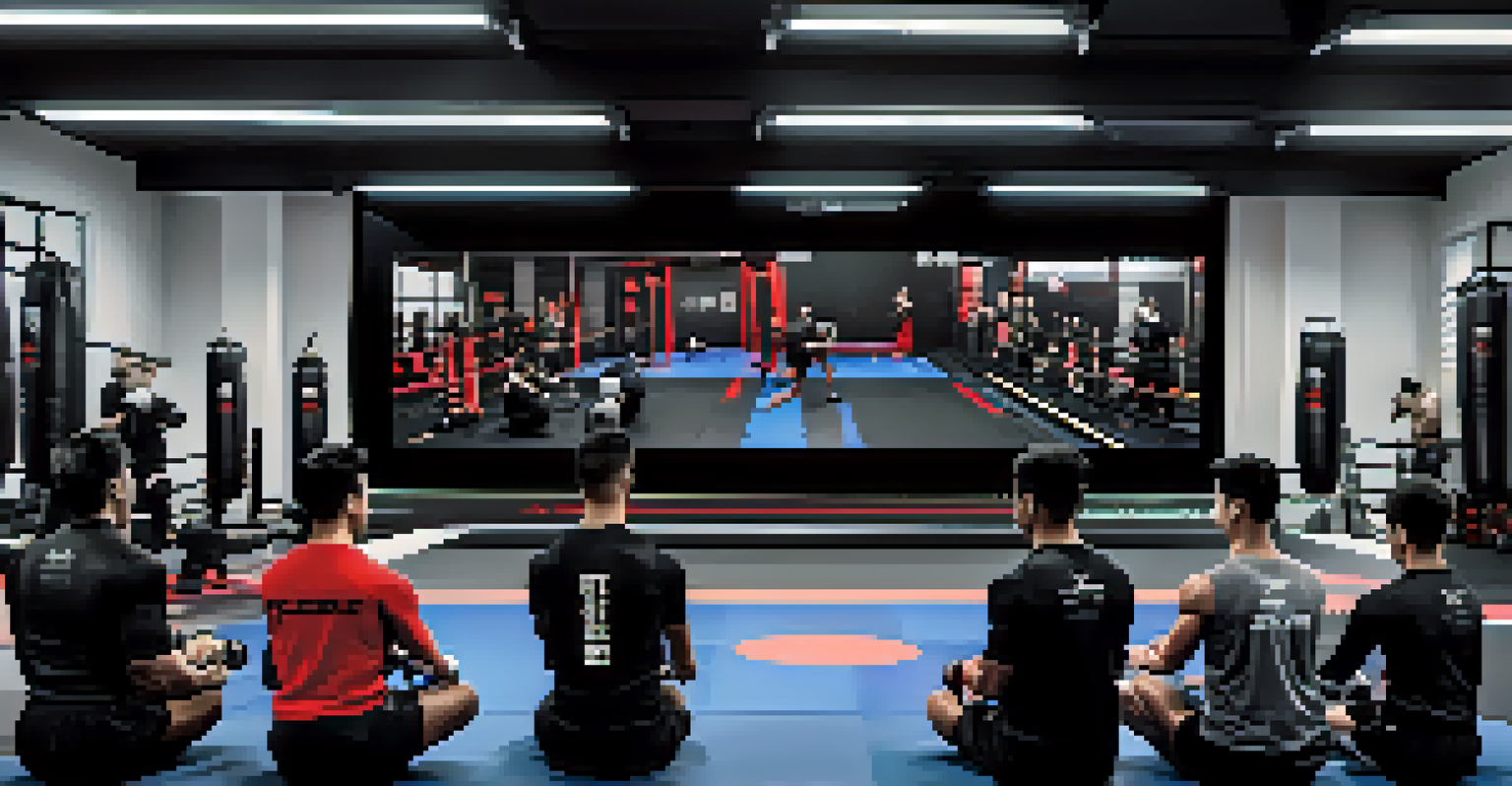The Evolution of Sparring Rules in Martial Arts Tournaments

Understanding the Origins of Sparring Rules
Sparring rules in martial arts have roots that trace back centuries, often influenced by the cultural and historical context of the time. In ancient martial arts, sparring served as a practical way for warriors to practice their skills in a controlled environment. These early forms of sparring had few rules, focusing primarily on survival and combat effectiveness rather than sportsmanship.
Martial arts is not about the defeat of others but the mastery of oneself.
As martial arts evolved, so too did the necessity for rules that could ensure safety and fairness during practice and competition. The need for structured sparring became evident as martial arts gained popularity, leading to the establishment of formalized rules. This shift allowed practitioners to engage in sparring with less risk of serious injury, paving the way for more organized competitions.
In essence, the origins of sparring rules reflect a balance between the need for effective training and the desire to create a safe environment for practitioners. This evolution laid the groundwork for the diverse rulesets that would emerge in various martial arts disciplines.
The Impact of Traditional Martial Arts on Sparring Rules
Traditional martial arts, such as Karate and Taekwondo, have significantly influenced the development of sparring rules. These disciplines often emphasized respect, discipline, and the philosophical aspects of martial arts, which translated into their sparring practices. As a result, many traditional styles adopted rules that emphasized controlled techniques and limited contact to promote safety.

In traditional Karate competitions, for instance, the concept of 'controlled contact' is paramount. This rule encourages practitioners to focus on precision and technique rather than sheer power, fostering a spirit of respect among competitors. By prioritizing technique over aggression, traditional martial arts helped shape a competitive environment that values skill and sportsmanship.
Evolving Sparring Rules for Safety
The development of sparring rules has prioritized safety, balancing effective training with the need to minimize injuries.
This influence is evident in how sparring rules have been crafted to minimize injuries while still allowing for effective training. The emphasis on respect and control in traditional martial arts continues to resonate in modern sparring rules across various disciplines.
Modernization of Sparring Rules in Competitive Martial Arts
As martial arts gained global popularity, there was a clear need for standardized sparring rules to accommodate a wider audience. This modernization process involved creating uniform regulations that could be applied across different tournaments and organizations. Such standardization not only facilitated fair competition but also helped in promoting martial arts as a legitimate sport.
The ultimate aim of martial arts is not having to use them.
Organizations like the International Olympic Committee (IOC) played a crucial role in this evolution, particularly with the inclusion of sports like Taekwondo in the Olympics. This brought about stricter regulations regarding scoring, fouls, and safety gear, ensuring that sparring was both competitive and safe for athletes. The modernization of rules has allowed martial arts to reach new heights and attract participants from diverse backgrounds.
Ultimately, the modernization of sparring rules reflects the growing recognition of martial arts as a respected sport. With clearer rules and regulations, practitioners can compete with confidence, knowing that their safety and fairness are prioritized.
The Role of Safety Gear in Sparring Rule Evolution
Safety gear has become an integral part of martial arts sparring, shaping the rules that govern competitions. The introduction of protective equipment, such as helmets, gloves, and shin guards, significantly reduced the risk of injury during sparring sessions. This emphasis on safety led to the establishment of rules that mandated the use of specific gear in competitions.
For example, in many Karate tournaments, participants are required to wear gloves and foot protectors to minimize the impact of strikes. This not only protects the athletes but also influences the way they engage in sparring, encouraging more controlled techniques. The evolution of safety gear has thus played a pivotal role in transforming the culture of sparring from one of raw competition to a more regulated and safer environment.
Impact of Traditional Arts on Sparring
Traditional martial arts have shaped sparring rules by emphasizing respect, discipline, and controlled techniques.
As martial arts continue to evolve, the incorporation of advanced safety gear will likely shape future sparring rules. Innovations in protective equipment could lead to even more comprehensive safety standards, ensuring that martial arts remains a safe and accessible sport for everyone.
The Influence of Mixed Martial Arts on Sparring Rules
The rise of Mixed Martial Arts (MMA) has had a profound impact on sparring rules across various martial arts disciplines. MMA introduced a more dynamic and aggressive style of competition, prompting other martial arts to reassess their sparring rules. This cross-pollination of ideas has led to a blending of techniques and rules that enhance the overall effectiveness of sparring.
For instance, the emphasis on practical applications in MMA has encouraged traditional martial arts to adapt their sparring practices. Many dojos now incorporate elements from MMA to prepare their students for a broader range of combat scenarios. This evolution has led to a more comprehensive understanding of sparring as not just a sport but a practical application of martial arts techniques.
As martial artists continue to learn from each other, the influence of MMA on sparring rules is likely to persist. This ongoing evolution will create a more versatile generation of martial artists capable of adapting to various styles and scenarios.
The Role of Technology in Shaping Sparring Rules
Technology has increasingly played a role in shaping the rules and practices of sparring in martial arts. With advancements in video analysis and performance tracking, coaches and athletes can evaluate sparring sessions with a level of detail that was previously unattainable. This data-driven approach has led to a better understanding of effective techniques and strategies.
Moreover, technology has contributed to the development of smart protective gear that can monitor impacts and provide feedback on performance. This innovation not only enhances training but also informs rule adjustments aimed at improving safety. As technology continues to evolve, it will undoubtedly influence the future of sparring rules and practices.
Future Trends Emphasizing Inclusivity
Future sparring rules are expected to focus on inclusivity and evidence-based practices to accommodate diverse practitioners.
In this context, technology serves as a tool for enhancing the martial arts experience, making it safer and more effective. As practitioners embrace these advancements, the way sparring is conducted and regulated will continue to evolve.
Future Trends in Sparring Rules and Practices
Looking ahead, the evolution of sparring rules in martial arts will likely continue to adapt to societal changes and emerging trends. One potential trend is the increasing focus on inclusivity, with rules evolving to accommodate practitioners of all ages, sizes, and abilities. This shift could lead to more diverse competition formats and greater participation across various demographics.
Additionally, as the understanding of sports science grows, sparring rules may incorporate more evidence-based practices. This could involve refining rules around contact levels, recovery protocols, and injury prevention strategies. The aim would be to create a more sustainable environment for practitioners while maintaining the competitive spirit of martial arts.

Ultimately, the future of sparring rules seems poised for further transformation, driven by a commitment to safety, inclusivity, and effectiveness. As martial arts continue to evolve, so too will the rules that govern the practice, ensuring that it remains relevant and accessible to all.